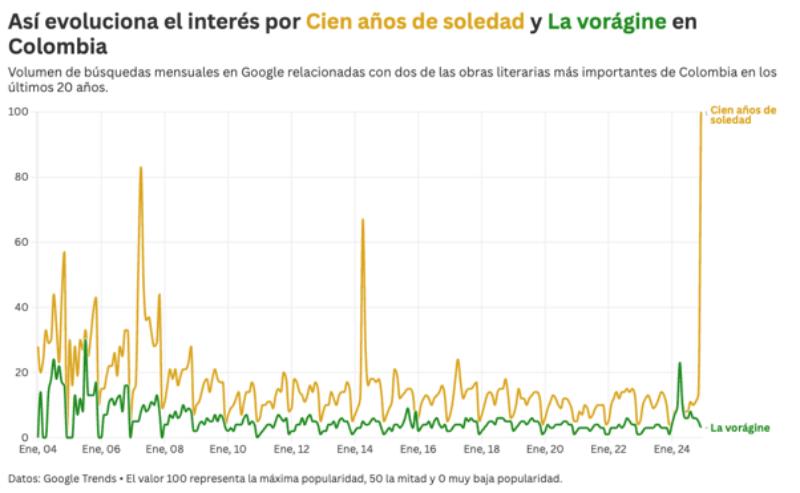How has the interest in One Hundred Years of Solitude and The Vortex changed?

At Datasketch, each month we create a cultural agenda with a different theme. This April, we’re dedicating it to literature and its relationship with data—and what better time to do so than around International Book Day, celebrated on April 23.
Today, we’re sharing an example of how data can tell us stories about some of the most outstanding books in Colombian literature.
Search trend data since 2004 shows that One Hundred Years of Solitude has maintained a steady level of interest over the years, with specific spikes linked to anniversaries, the author’s death, or productions based on García Márquez’s work.
In contrast, The Vortex has shown a year-by-year decline in interest over the same period. However, the commemoration of its centenary boosted search volumes, reaching the same level of interest as One Hundred Years of Solitude in April 2024.
In the chart below, you can see how the number of searches for each term has evolved over the last twenty years.

The Netflix series: a trigger for searches
In December 2024, One Hundred Years of Solitude, the landmark work by Gabriel García Márquez, reached a score of 100 — the highest recorded in the entire period analyzed. This phenomenon is explained by the release of a series based on the novel, which has generated renewed interest both in Colombia and internationally. Previously at Datasketch, we analyzed the main topics of interest related to this work in Latin America, which you can find [here].
Before that, the highest search levels for García Márquez’s masterpiece occurred in April 2007, when it turned 40, and in April 2014, after the author’s death.
The Vortex: a resurgence of interest on its centenary
Meanwhile, The Vortex, the novel by José Eustasio Rivera, reached its highest number of searches in April 2024, with a score of 23 — a significant increase compared to previous months. This interest coincides with the commemoration of the date on which the author completed the work in 1924, a milestone celebrated with cultural, academic, and media events that highlight the importance of this novel as a piece of social criticism and a literary testimony to the Colombian plains and the exploitation of rubber.